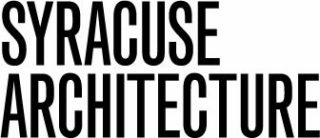Table of Contents

Hip-Hop, the dominant cultural movement of our time, was established by the Black and Latino youth of New York’s South Bronx neighborhood in the early 1970s. Over the last five decades, hip-hop’s primary means of expression—deejaying, emceeing, b-boying, and graffiti—have become globally recognized creative practices in their own right, and each has significantly impacted the urban built environment.
Hip-Hop Architecture is a design movement that embodies the collective creative energies native to young denizens of urban neighborhoods. Its designers produce spaces, buildings, and environments that translate hip-hop’s energy and spirit into built form. Some 25 years in the making, Hip-Hop Architecture is finally receiving widespread attention within the discipline of architecture thanks to a series of influential essays, lectures, and presentations by Craig Wilkins, Michael Ford, and this show’s curator, Sekou Cooke. During this period of emergence, the movement’s ideals have primarily been tested by a loosely organized group of pioneering individuals, each using hip-hop as a lens through which to provoke and evoke architectural form. Close to the Edge: The Birth of Hip-Hop Architecture exhibits the work of these pioneers—students, academics, and practitioners—at the center of this emerging architectural revolution.
The exhibition, on view at the Center for Architecture October 1, 2018 – January 12, 2019, included work by 22 participants representing five countries, with projects ranging across a variety of media and forms of expression: from experimental visualization formats and installation strategies, to façade studies, building designs, and urban development proposals. In aggregate, these projects reveal a collective vision for alternative forms of expression and practice, and serve to formalize work created over the past 25 years into an emerging canon of Hip-Hop Architecture.
The work as originally exhibited was identified using three primary characteristics: hip-hop identity; hip-hop process and hip-hop image. The first includes authors who self-identify with the hip-hop community; the second invokes a method of production using specific hip-hop techniques or values; and the third creates products recognizable as part of an established hip-hop aesthetic. The selections presented here cover each of these three categories and represent a cross-section of the various approaches included in the show.
Curator:
Sekou Cooke
Exhibition Design:
Sekou Cooke
Graphic Design:
WeShouldDoItAll with graffiti by “Chino”
2018 President's Circle
Sponsors:
Arup Consulting Engineers; Ennead Architects LLP; Gilsanz Murray Steficek, LLP; Herman Miller Cares; Langan; Sciame Construction LLC; Skidmore, Owings and Merrill LLP; Thornton Tomasetti; Zetlin & De Chiara, LLP
Supporters:
AKF Group LLC; Anchin; Architecture Research Office; Barco; Benhar Interiors; Capalino + Company; Dagher; Ingram, Yuzek, Gainen, Carroll & Bertolotti; James McCullar Architecture PC; Kohn Pedersen Fox Associates; O’Donnell & Naccarato Structural Engineers; Prosurance Redeker Group; Sage and Coombe Architects; STUDIOS Architecture; Syska Hennessy Group, Inc.; Tillotson Design Associates, Inc.
Friends:
Cameron Engineering & Associates of New York, PLLC; Cameron MacAllister Group; COOKFOX Architects, DPC; Dan Kaplan, FAIA; Eve Klein Consulting; Hausman LLC; Heidi Blau; Henry Zachary; ikon.5 architects; John Schuyler; Levien & Company; M. Kathryn Devlin; Mark Strauss and Jaye Medalia; Roslyn Consultants, LLC; Sylvia Smith; Tom Krizmanic, AIA
Grants and Public Funding
Close to the Edge: The Birth of Hip Hop Architecture is supported, in part, by a grant from the Graham Foundation for Advanced Studies in the Fine Arts
Close to the Edge: The Birth of Hip Hop Architecture is supported, in part, by public funds from the New York City Department of Cultural Affairs in partnership with the City Council.

